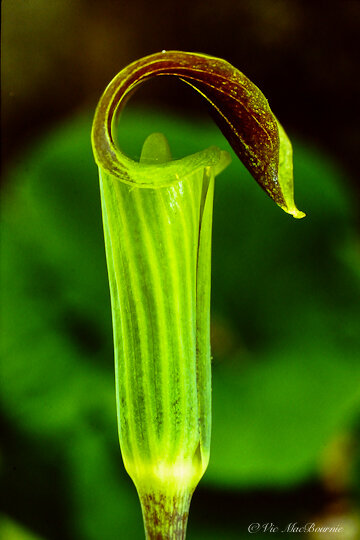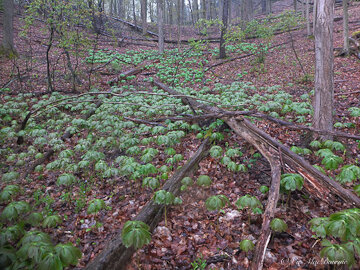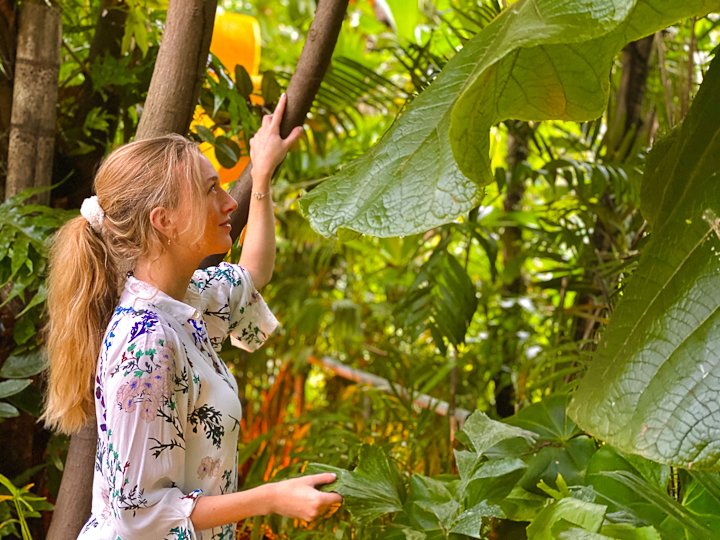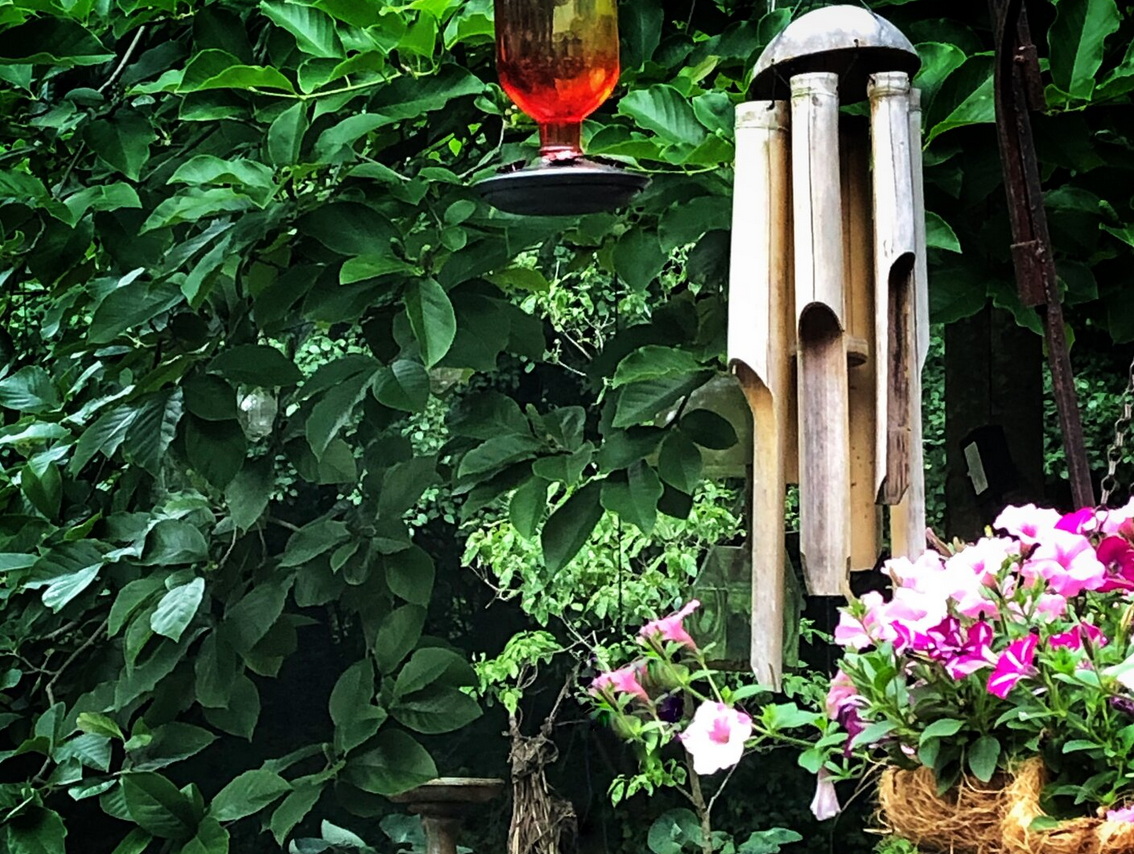Foliage and texture in a woodland garden design
Woodland gardens are dependent on foliage texture for much of their subtle beauty. Three native plants, ….. Jack in the Pulpit, Solomon’s Seal and Mayapple are three plants that are standouts in the woodland garden for their foliage rather than their subtle flowers.
Jack in the Pulpit shown in lovely light in our front woodland garden.
Three native plants to consider: Jack-in-the-Pulpit, Solomon’s Seal and Mayapple
Woodland gardeners know that not all flowers need to be colourful, but all gardens benefit from incorporating highly textured foliage plants.
In fact, some of the most interesting woodland plants are very understated: flowers are often green and are even hidden beneath the plants’ own leaves.
Unlike the often bright colours found in many traditional perennial gardens, woodland gardeners have learned to appreciate the subtle beauty of these foliage-based plants. They know that it is the highly textured foliage of these plants, the different shades of green, leaf shape, fall colours and even the colourful berries, that make these understated plants extremely valuable in the woodland landscape.
When it comes to understated plants that rely on textures and foliage, three plants come to mind: Solomon’s Seal, Jack in the Pulpit, and Mayapple. But there are many others that add interest to our woodland floor that often go unnoticed.
Ferns, mosses, stonecrops, and so many other plants help to build the tapestry that make up a woodland garden.
In her book Foliage & Garden Design, garden writer Marjorie Harris turns her focus on the importance of using foliage as the star in garden design.
“The foliage garden is a restful place where beauty unfolds more slowly than in a perennial garden,” Harris writes. “It’s a place where the textures of leaves are far more important than the colours of flowers. Foliage plants can have blossoms and berries, lure butterflies and birds and provide a sanctuary and a shelter.”
She goes on to explain an important concept in a shaded woodland garden.
A fern glen in the woodland garden creates a large exapanse of texture in a sea of green.
“Establishing a foliage garden means entering a more sophisticated world both aesthetically and visually,” she explains.
Compared to the perennial garden that is often so dependent on great drifts of colour, gardens based on foliage are more muted and subtle. “Verticals and horizontals; distance and perspective; positive and negative spaces; mass and shape – these become your tools,” Harris explains.
If you are interested in pursing more about designing a garden with foliage, the Harris book is still available on the Amazon.com used market here.
Why are some plants’ flowers so understated?
In a world where colour plays an important role in attracting pollinators, birds and butterflies for a plant’s survival, the question needs to be asked: Why are some woodland wildflowers so understated? It’s possible that many plants in the woodland are understated for their own survival. By staying under the radar, they are able to escape many of the animals that might want to browse on them for dinner.
Whatever the reason, it’s important for gardeners to learn to appreciate their presence in the shady areas of our woodlands.
Three subtle plants that add interest through foliage
Jack-in-the-Pulpit stands above the crowd: Arisaema triphyllum, commonly named Jack In The Pulpit is a favourite in our garden as much for its unusual shape, as it is for its bright red berries that emerge in the fall.
The plant, which is found throughout the north-eastern United States and stretching into Ontario, Quebec and the Maritimes, earned its name for its resemblance to a preacher standing in a pulpit.
Dominated by a large, cylindrical and hooded flower that grows almost unnoticeable at first from beneath two large, glossy leaves, this mostly green flower with brown stripes can grow to between 1-3 feet tall.
By late summer, the flower is replaced by a large cluster of bright red berries that is an attractive meal for many birds and mammals. (Note that the roots and berries of this plant can cause blisters on the skin and irritation in the mouth and throat if ingested.)
Each berry in the cluster contains 1-5 seeds that are attractive to wood thrushes and wild turkeys as well as squirrels and even box turtles.
A 1980 study found that fungus gnats may be the most effective pollinators of these unusual plants. Pollination is performed when the gnat or other small insect makes its way to the spadix or column often referred to as the “Jack.” The columnar ends with a sheath called a spathe. The spadix contains male or female flowers (or both). Pollinators crawl beneath the hooded spathe, down the spadix collecting pollen from the flowers.
According to the Nature Conservancy of Canada, Jack-in-the-pulpit is being threatened in natural woodlands by invasive alien species such as garlic mustard and buckthorn.
Solomon’s seal is a favourite for shade gardeners
The arching stems of Solomon’s Seal rising above other plants in our front woodland garden is always a welcoming site in spring.
Polygonatum, also known as King Solomon’s-seal or just Solomon’s seal, is known for its zig-zag arching stalks that can grow up to 5 feet long and sport nodding, greenish-white, tubular flowers that hang in pairs below the stalks.
Their tubular whitish flowers, often among the earliest flowers to bloom in the woodland, droop down beneath the stalk and are attractive to hummingbirds.
Check out my complete article on Solomon’s seal.
Butterflies are also attracted to the delicate spring blooms of the Solomon seal flowers.
The green flowers eventually transform into large blue berries that are favoured by the Veery, American Robin, Wood Thrush and Bluebird
Solomon’s seal prefer a woodsy soil of moist, rich acidic soil but can also be found growing in more sandy or even clay loam.
If you are looking for a plant to grow at the base of a tree, consider growing a clump of them at the base of a tree.
Mayapple: An ideal shade-loving ground cover
The Mayapple earned its name from the large, apple-like fruit that grows under the umbrella of its large leaves where it often goes completely unnoticed by woodland gardeners.
The early spring wildflower, which can be highly poisonous provides much needed nectar for pollinators and the large, “apples” are eaten (only when competely ripe) by raccoons, skunks, opossums and even box turtles.
The mayapple can spread to incorporate large swaths of woodland where the conditions are right and are therefore excellent for use as a large, bold groundcover.
Mayapple is one of the first Carolinian zone wildlflowers to emerge in the spring in the woodlands of southern Ontario and the northeastern United States, so it became a magnet for many of us photographers just looking for something, anything, to focus on in the early spring woodlands.
So, you can imagine that it didn’t take long for me to start growing a clump in my yard. Turns out it was so successful that I was able to spread it around where it continues to thrive in swaths throughout the garden.
The Mayapple is actually in the Barberry family and grows naturally everywhere in the eastern half of the United States stretching as far north as Quebec and south to Florida and Texas.
For more on the Mayapple, go to my earlier post located here.
• As an affiliate marketer with Amazon or other marketing companies, I earn money from qualifying purchases.
Raised planters are a hit in the woodland garden
Living with deer is a wonderful experience. Everyday I see them browsing through the yard is both a joy and a horror. What are they after today? Will the prized hostas survive this time around? So, why not serve them a delicious smorgasbord right at the perfect eating height. We decided to experiment with veggies and herbs this year in raised planters. I know the rabbits can’t get them but I have a feeling the deer are going to thank me big time. Follow along this summer and see if the deer get more produce than I do from our raised-planter experiment.
From veggies to garden nursery, changing strategies
The two raised planters to the left in the photo fit in nicely with the Keter sheds (that’s a second, smaller shed on the right) and the two on-ground planters, also made by Keter, that flank each side of the shed doors.
We bought our home based on a picture the previous owners left on the kitchen table at the open house.
It was a picture of two deer walking through the yard.
That sold it for me.
At the time, my wife, daughter and I were living in the suburbs surrounded by homes, pools and annoying neighbours. I spent my evenings and weekends in the nearby town of Ancaster (where we now live) trying to get photographs of deer. At that time, I was a little obsessed about getting photos of these lovely creatures.
Lots of deer: Careful what you wish for
When we bought the Ancaster home, one of the first projects I did was set up a bird-feeding station. It wasn’t long before the deer came to the bird feeders and it wasn’t long after that I came to the realization that if birds came to my feeders, I bet deer would come to feeders especially made for them.
I was right.
One morning I woke up to 17 deer in the yard waiting for me to go out and fill their feeder.
In fact, by about the third year of feeding the deer, they would be waiting for me when I returned from work around midnight.
For more suggestions and some of my favourite garden things, be sure to check out my Favourite Things post.
Five, six, eight would be in the yard gathered around the feeder. They were so used to me by that time that they would back off only about three feet when I approached them with their special feed of oats and corn.
They became so friendly that I’m sure they would have let me touch them, if I ever tried.
It got to the point where we couldn’t sit outside without being visited by a couple of deer looking for a handout.
The two raised planters are seen here with the woodland garden in the background.
High cost of feeding deer
Eventually, I realized, however, that we could not have anything nice because of the all the deer.
Not only were they eating me out of house and home, but they treated my emerging garden like a smorgasbord – the garden was the salad and the feeder became the main course.
A number of on-line nurseries offer assistance on buying deer-resistant plants. They are worth familiarizing yourself with so you don’t spend a fortune feeding the deer with precious plants.
The Burpee site is another mail-order company offering an extensive list of deer-resistant perennial seeds and plants for purchase through mail order.
I cut down on the food and eventually fewer deer visited looking for handouts.
Don’t get me wrong, they are still welcome in my garden and continue to indulge on our hostas, but the tradeoff of having these magnificent animals around is well worth it to me.
Before I plant anything these days, I check to see if they are deer resistant. I’ll still use plants that I know deer enjoy, but I try to put them in areas that are a little difficult for the deer to reach. It doesn’t work, but I keep trying.
The Keter raised planter pictured here prior to being filled with soil shows the watering system at left and the plastic spacers that both give the unit support and act as dividers for different herbs or veggies.
Lots of visitors to the woodland wildlife garden
Deer, of course, are not the only garden visitors. Rabbits, groundhogs, squirrels (both grey and red) chipmunks and a host of other hungry visitors live here too. So the thought of growing vegetables had never really crossed my mind until recently.
Mary Reynolds’, The Garden Awakening, (see earlier blog) got me thinking about Forest Gardening. A little research on YouTube especially New Jersey YouTuber James Prigioni got me thinking maybe it was time to tackle a little more food cultivation in the garden.
Problem is, besides berries from the many Dogwoods on the property, crabapples, serviceberries and various nuts from trees, I was convinced vegetables and low-growing berry crops would not stand a chance in the garden. There are ways to keep the critters out but I was not interested in fencing my property.
Just fencing off a small area using something like the Pest Free Garden from Gardeners’ Supply Company would certainly get the job done.
But I decided to go with raised planters.
A quick visit to our local big-box store resulted in not one but two handsome black, self watering raised planters made by a company named Keter for a garden area I am developing in front of a new shed. It didn’t hurt that the raised planters were made by the same company that made the shed and, therefore, fit nicely into the grey and black colour scheme. Check out my review of the Keter shed here.
Simple to assemble raised planters
It also was not a coincidence that as soon as I saw the raised planters at Costco, I grabbed them. After purchasing more Keter garden products in the last year and a half than I care to admit, I knew the quality of these Keter Urban Bloomer XL raised planters would be top notch and assembly would be simple and satisfying.
Construction, however, didn’t start well.
I overlooked the instructions for the first planter in the box so, like most men, decided to proceed without them. First thing I did was break a tab off the leg trying to detach it from the packaging. I’m not all that handy, so breaking things before I even get started is not out of the ordinary.
I had three more legs to detach and, for the life of me, I could not figure out how to detach them without breaking them off. Second leg, same thing. Broken tab.
I knew Keter products well enough by now to know that this was not the norm with their products. Everything else I built from them (and like I said there were many) made Ikea look like amateurs.
It was about that time that I discovered the instructions in the box.
Well, guess what? The tabs were meant to be broken off from the packaging material. Wow, I thought to myself, not only do I get to build these things, but I even get to break things on purpose. Life is just too good.
A few minutes later and the first one was built. After already building one (without instructions for the most part), the second one went together even easier and quicker. Within 1/2 an hour or so, both were built and in place ready for soil and seeds.
Keter states that with The Urban Bloomer XL, there’s no need to dedicate lots of space to have a substantial vegetable garden.
And, for us old folks, no need to bend over while planting and harvesting our veggies. That’s a good thing.
The extra-large elevated planter ( capacity of 110 L | 29.06 Gallons) features a shelf for storing gardening supplies and a smart watering system that incorporates special fabric for evaporation and regulated watering.
Its 44.8 inches in length and 18.6 inches in depth provides plenty of space for planting vegetables and herbs. The planters are advertised as UV and weather resistant, requiring virtually no maintenance and are easy to clean. What more can you ask for? A drainage plug at the bottom of the planter provides a convenient way to reduce the amount of water if necessary.
They are also quite light even with soil in them and would make the perfect raised planter for a balcony or small courtyard.
Their dark colour makes them not only a stylish addition to a balcony or patio, but also works to absorb heat to keep plants happy from early Spring through the cooler Fall temperatures.
One thing I can say about Keter is that the vinyls/plastics they use in their products are outstanding.
I’ve always been a natural-materials guy, but when I discovered how realistic Keter products are, I was sold. In fact, the company has won awards for the vinyls they have created. I joke that our grey-weathered shed looks more like weathered cedar than real weathered cedar looks. And it was weathered the day we bought it. I didn’t have to wait for it to take on that beautiful weathered grey colour.
Will they work to keep deer away
Keter doesn’t say anything about deer though.
In fact, after assembling them, I realized that my planters are raised to the perfect height for our four-legged friends to chow down with the greatest of ease.
They will definitely keep the rabbits away but I’m not too sure about the deer.
Oh well, it wouldn’t be the first time I set up a buffet for our resident deer.
And, like I said, watching them enjoy my backyard as much as I do, is a small price to pay.
Just leave me a tomato or two would you guys… I do like my toasted tomatoes.
Throughout the summer, I’ll keep readers updated on my success and failures with my raised planters.
Raised planter update
Okay so after our first summer with the raised planters I can report that I did not see a deer munching my tomatoes. I can also report that the deer missed out because one of our local raccoons got there first. Turns out a local raccoon decided to help itself to the tomatoes and snap pees.
Back to square one. This year we moved the planters around to the side of the house and although I have not given up with the tomatoes and other veggies, I am converting the raised planters to more of a woodland wildlife nursery where I can begin growing woodland flowers and shrubs from cuttings and seeds. I predict that will be a little more productive in the long run.
I hope to pick up some garden cloches from Garden supply to deter the raccoons from what is left of my tomatoes and other veggies.
If you like Keter products, and you are as disorganized as I am, you might want to consider getting their shed tool organizer. Again it’s another high quality product that solves the problem of messy tools cluttering up your tidy shed.
• None of the products in this review were provided to me from Keter. They were all purchased by me at a local Big Box Store.
As an Amazon Associate I earn from qualifying purchases. This page contains affiliate links. If you purchase a product through one of them, I will receive a commission (at no additional cost to you) I only endorse products I have either used, have complete confidence in, or have experience with the manufacturer. Thank you for your support.























Luminar Neo’s powerful photo editing package goes mobile.